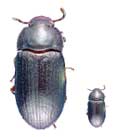|
"Nabarang" is an illness attributed to another form
of sorcery, performed by the specialist called "mambabarang."
The illness is caused by insects called "barang," identified
through suspected specimens and descriptions as Alphitobius laevigatus. The insects look like flies, and are carefully
tended to and fed black ginger by the mambabarang in bottle or
bamboo tubes. (insert)
|
 Alphitobius
laevigatus Alphitobius
laevigatus
(Fabricus) 1781
The much enlarged
image at <http://entnemdept.ufl.edu/teneb/a_laevigatus.htm>
describes
it as a cosmopolitan "black fungus beetle," 5.0-6.5
mm length. At 5 mm it could be mistaken as a fly, and at that
size could be small enough to do its dastardly mission of invading
through body portals.
|
In themselves, the insects are harmless
but become dangerous when the mambabarang decides to use them for purposes
of sorcery and possession. The mambabarang performs a prayer ritual,
whispering to the insects instructions and the name of the intended
victim. The barang insects are then set free to seek and enter the through
any of portals: the anus, the nose, the ears, or dermal breaks likes
wounds and scratches. The illness manifestations will depend on the
barang's portal of entry: the anus, hemorrhoids or almoranas; the ears,
severe earaches; the nose, epistaxis or balinguyngus.
The affliction is also characterized
by the presence of a typical scarring, sugat-sugat, variedly
colored from yellow to red to violet and black, usually generalized,
but specially affecting the face and arms.
The illness is not amenable
to treatments by the traditional physicians. Only another mambabarang
or a specialist and counter the barang and its illness.
F. Jocano Locando's Folk
Medicine in a Philippine Municipality suggests that the practice
may be indigenous to the Bay-Laguna area.
In some parts of rural Quezon, nabarang
is recognized as a form of illness induced by kulam or sorcery - an
illness manifestating as a protracted intestinal disease, resistant
to the ministrations of traditional and alternative healers, and the
cause finally revealing itself when the patient dies and flying insects
are released from the body cavities or dermal breaks.
|





